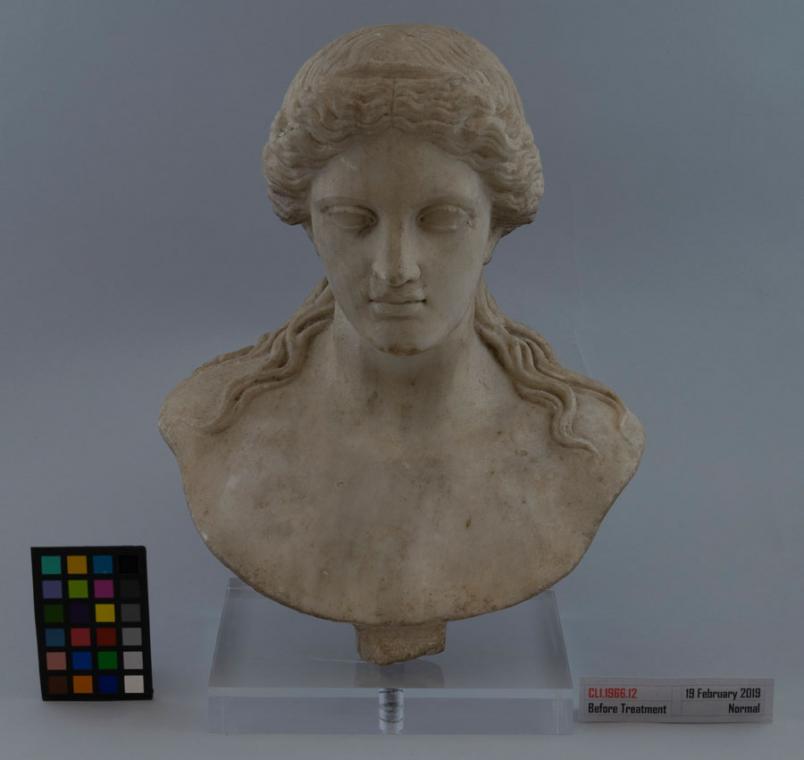Preparing for The Light Show exhibition gave the Denver Art Museum the opportunity to delve deep into its collection to find artwork and artifacts related to the theme of illumination. It was therefore fitting that a marble bust of Apollo, the God of Light, the Sun, Music, and Prophecy, was selected for a prominent place in this show.

Before treatment. Bust of Apollo, Roman Empire, 100s. Marble. Museum purchase, 1966.12. Photo by Aaron Burgess.
Bust of Apollo hadn't been treated by the museum’s conservation team since it was acquired in 1966. When it arrived in the conservation lab, it was covered in dirt, consistent with an artifact unearthed in an archaeological excavation. Because the marble was porous, this made the removal of the dirt somewhat challenging. Any cleaning solution we used would have forced the dirt deeper into the marble, staining it indefinitely. With this in mind, we decided to apply a poultice, which delivers a cleaning solution to the surface of the marble and draws the dirt and the moisture back into the poulticing material as the treatment progresses.

During treatment – removing the agar/chelator poultice from the Apollo bust. Bust of Apollo, Roman Empire, 100s. Marble. Museum purchase, 1966.12. Photo by Aaron Burgess.
Conservators always look to find new treatment methods, and share these with their colleagues in order to advance our profession as a whole. In the past few years, several of our peers in the wider conservation community have been successfully experimenting with agar and promoting it as a poulticing medium. We had not tried this approach and we were keen to give it a go. Agar is a gelatinous substance collected from various seaweeds/algae. It’s used as a thickening agent in certain foods, but you are probably most familiar with the version used in high school biology to grow bacteria in a petri dish.
We decided to combine the agar with a chelator; a chemical that grabs on to metal ions like a claw—which incidentally is where the word derives from (chele is Latin for ‘pincer’). You may have heard of medical chelation therapy, which is a method for removing heavy metals from the human body. The same kind of idea can be used to enhance the removal of soiling from an artwork, given that dirt typically has a high metal ion content. The heated agar/chelator solution was applied liberally to the marble bust using a brush. As it cooled, the agar hardened to a thick gelatinous skin, absorbing the dirt and residual moisture at the same time. The agar was then peeled off, taking the dirt with it. This process was repeated several times, with each application yielding less dirt. Overall, the treatment was quite successful in reducing the grime. The image below shows how much more of the marble was exposed in the cleaning.

After treatment. Bust of Apollo, Roman Empire, 100s. Marble. Museum purchase, 1966.12. Photo by Aaron Burgess.
While cleaning the sculpture, we found two small regions of a dull beige paint. Ancient sculptures were typically painted, so this discovery meant that we had to stop and analyze the paint pigments in order to determine whether the polychromy was likely original to the piece.

Location of the paint sample. Bust of Apollo, Roman Empire, 100s. Marble. Museum purchase, 1966.12. Photo by Aaron Burgess.
Using an X-ray Fluorescence (XRF) Spectrometer, we were able to analyze the elemental components of the paint and determine that it contained high levels of aluminum and titanium. Most paint pigments contain specific chemical elements that aid in their identification, and many of these pigments have very specific production dates. Titanium (titanium oxide in this case) has only been used in pigment production in the 20th century, and a combination of compounds containing both titanium and aluminum is often used to extend and opacify house paint.

Analyzing the paint sample with a handheld XRF spectrometer. Bust of Apollo, Roman Empire, 100s. Marble. Museum purchase, 1966.12. Photo by Aaron Burgess.
Needless to say, we were fairly confident that the polychromy was not original, but more likely the product of a recent misadventure in interior decoration. That said, whenever the conservation team finds pigment remnants on an ancient piece of art, we have a responsibility to investigate it. It would be anathema to our profession to remove an authentic feature of an artwork. And, if the polychromy had proven to be original, it would have presented an exciting opportunity to share this with our curators and educators, and demonstrate an even richer understanding of the artwork to our patrons.
The Light Show is on view at the Denver Art Museum through May 3, 2020. It is included with general admission, which is free for members and youth 18 and under.
Photo at top: Gallery view of The Light Show. Photo by Jena Pruett.

